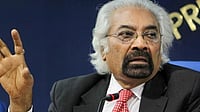EVERY weekday evening, cars all shapes and sizes screech to a halt in a narrow lane in Delhi's posh Panchsheel Enclave. People, all shapes and sizes, spill out to the soft strains of the gracious waltz wafting from a two-storied building. In a flurry of sarees, dupattas, business suits and stuffy ties, they rush down the steep stairs to the brightly-lit basement, as the music changes to a perky polka. For there's a pirouette party on every evening from 8 to 10, where corporate executives young, middling and old, housewives and business professionals, doctors and ad persons dance the day's stress away to foot-tapping music.
The basement housing the Studio d' Espirit dance hall is the focus of a new rhythmic wave in the efforts to beat the scourge of the 20th century, STRESS. Awareness is high that exercise is a must, but the desire to step into a gym hits an all-time low after a day that's left you feeling like a limp rag. Instead of...a one and two and stretch and turn...you'd rather stretch out on the nearest couch with a stiff drink. Yet, those endomorphins are screaming to be let loose. That's why professionals are flocking to the Studio's dance classes which allow them a couple of hours of pure fun—and exercise.
Says Neeta Garg, 34, aerobics expert: "There's a trend moving towards dance as a fun form. Aerobics can be very strenuous for some. But dance is a great form of recreation which energises and de-stresses." Agrees Sajal Bannerji, 38, a fitness instructor who's recently joined the classes: "The laughter, which is what attracted me in the first place, is missing in aerobics or other forms of exercise. You'd be surprised at how much you can trim down by just dancing and letting yourself go."
The Studio's dance teacher, Kiran Kalanauria, elaborates on the popularity of this newest form of exercise. Dance is a manifestation of the body's natural movements, he explains, embodying all the rasas—joy, anger, tension, sorrow, love, passion, ultimately moving towards peace and calm. It allows one to work off inner turmoil and reach a state of abandon, leaving you with a sense of a perpetual high. Too over the top, one might think. But speak to Mumbai-based celebrated dancer and choreographer Shiamak Davar and the response is much the same. "Dance has a universal appeal. Most people learn dance for the fun of it. But the positive benefits of health, fitness and harmony that they get comes as a surprise."
Rings true when one sees the twirling couples on the floor contorting uninhibitedly to the cha-cha, hustle and rock n' roll and more rushing in, hoping they hadn't missed too many turns.... One such couple in a hurry is Sanjeev Purushottam, 34, who holds a high-tension job at American Express, and his wife Harveena, 31, who works for a trading company. Their day starts at 8 am. But for all the pressures at work and at home, they wouldn't miss a single class for as Garg points out, dancing together also brings husband and wife closer. "It's the oldest form of body language," explains Lidia Pinhiero, a Brazilian dancer who takes classes at the Studio, "through which you understand life and learn to communicate—touch, feel. " More important, learn to relax. Ad person Vineeta Lal, 30, who spends long, sedentary hours in office, goes back to work after the class. Says she: "I don't go out too much at night because although I'm terribly fond of music and dancing, discos are too crowded. This gives me a welcome break."
For someone like businessman Raakesh Bhardwaj, 38 and single, it's killing a flock of birds with one stone. "My body movements are more fluid now". Unattached, the class makes up for the lack of an active social life. "I've made new friends, my inhibitions are gone and I look forward to dance parties as much as I look forward to coming here everyday." Executive Prabod Bhambal, 26, agrees, saying the atmosphere really peps him up. A sentiment borne out by the music, light-hearted flirting and camaraderie evident in the room.
Publicity for the classes is through word of mouth. More are filtering in to enrol themselves. Two twenty somethings walk in, one an optician, the other an exporter. "We finish work late. And this is one thing that goes on after that. It's fun, not aerobics, not exercise, somewhere in between," they say. That's the USP that Vandana Soni, owner of Studio d' Espirit, started off with. Designed to suit the executive who can't get off work before 7.30-8 pm, the Studio offers the opportunity to wind down after work with large doses of fun thrown in. Particularly for
people like Dr Veena Kapoor, 50 and single. With two grown-up children and a full-time job running her own psychiatric nursing home, Kapoor knows that she needs to exercise. "But I was bored of swimming," she says. "At my age I want to do other things. Doctors learn to study and work, they don't really know how to have fun." Also, it's not mindless flailing of arms and legs and pelvic thrusts. Kalanauria takes the group through sessions of graceful waltzes, foxtrots, tap-dancing, rock n' roll, jive, jitterbug, jazz and other such dance forms where synchronisation, discipline, communication and comfort levels are important.
Taking a cue from the Studio's 'de-stress through dance' other organisations are getting into the act. The British High Commission, for instance, plans to introduce dance as recreation for its employees after work hours. Says Helen D'Souza, of the High Commission's International Development wing: "People at the High Commission are considering it because it's a beautiful option." Landmark Forum, a Delhi-based family support organisation, has introduced dance as therapy for married couples.
The tempo changes at the Saturday afternoon classes in Delhi's Institute for Integrated Learning in Management. Part of the curriculum involving the Total Personality Development programme, 19-year-old management undergrads rattle and shake for four hours every week. This is the second year that the programme is in operation. Explains Institute dean Kamlesh Mishra: "Since we are trying to create management leaders, dance is a mechanism of confidence-building—the ability to do things when they know someone's watching them." Says second-year student Ashish: "We are not used to formal dancing, and especially with MNCS coming in, all this is necessary. Suppose someone asks you for a dance and you don't know what to do? It's part of corporate communication and improves body language and is rejuvenating." Very few bunk the Saturday sessions which see vigorous modern movements that do not tire but invigorate. According to Kalanauria, many schools are also thinking of introducing dance as part of the curriculum.
Our forefathers certainly knew what they were doing when at the end of the day the entire community gathered to the beat of drums, dancing the night away in harmony. Dance as a stress reliever in modern times is but a leaf taken from the ancient Book of Wisdom. It's about primeval instincts and natural movement. After a day of measured steps, allowing the body free rein, with music as the great soother, is probably the best way to wind down. The sheer ecstasy on the faces of this tribe of enthusiastic dancers is proof enough.


























